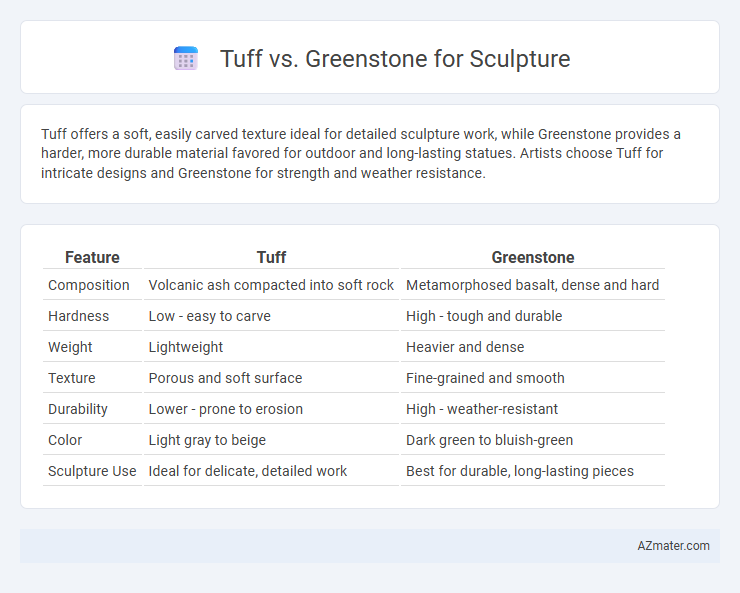Tuff offers a soft, easily carved texture ideal for detailed sculpture work, while Greenstone provides a harder, more durable material favored for outdoor and long-lasting statues. Artists choose Tuff for intricate designs and Greenstone for strength and weather resistance.
Table of Comparison
| Feature | Tuff | Greenstone |
|---|---|---|
| Composition | Volcanic ash compacted into soft rock | Metamorphosed basalt, dense and hard |
| Hardness | Low - easy to carve | High - tough and durable |
| Weight | Lightweight | Heavier and dense |
| Texture | Porous and soft surface | Fine-grained and smooth |
| Durability | Lower - prone to erosion | High - weather-resistant |
| Color | Light gray to beige | Dark green to bluish-green |
| Sculpture Use | Ideal for delicate, detailed work | Best for durable, long-lasting pieces |
Introduction to Tuff and Greenstone
Tuff and Greenstone are two popular materials used in sculpture, each with distinct geological origins and properties. Tuff is a volcanic rock formed from compacted volcanic ash, known for its lightweight texture and ease of carving, making it ideal for detailed artistic work. Greenstone, a dense metamorphic rock commonly found in regions like Zimbabwe, is prized for its durability and rich green hues, adding both resilience and aesthetic value to sculptures.
Geological Origins and Formation
Tuff, formed from volcanic ash ejected during explosive eruptions, consolidates into a porous, lightweight stone ideal for detailed sculpting, whereas greenstone originates from metamorphosed volcanic or sedimentary rocks undergoing intense heat and pressure, resulting in a dense, durable material valued for its hardness and fine texture. The silica-rich composition of tuff allows easier carving but less weather resistance, while greenstone's mafic minerals contribute to its resilience and deep green color, reflecting complex metamorphic processes. Sculptors choose tuff for intricate ornamental work and greenstone for robust, enduring statues that withstand environmental wear.
Physical Properties Comparison
Tuff exhibits a softer texture with a Mohs hardness rating of 3 to 4, making it easier to carve and ideal for intricate sculptural details, while greenstone, with a hardness of 6 to 7, offers superior durability and resistance to weathering for outdoor sculptures. The porous nature of tuff allows for better absorption of sealants, enhancing surface finishes, whereas greenstone's dense, fine-grained structure provides a smooth, polished appearance and longevity. Greenstone's higher compressive strength, often exceeding 150 MPa, supports larger, weight-bearing sculptures compared to tuff, which generally has a compressive strength below 100 MPa.
Color and Texture Differences
Tuff and greenstone exhibit distinct color and texture characteristics that influence their suitability for sculpture. Tuff generally features a lighter, often pale gray to tan coloration with a porous, soft texture that allows for ease of carving and detail work. Greenstone, known for its deep green to bluish-green hues, possesses a dense, fine-grained texture that provides durability and a smooth finish, making it ideal for intricate and long-lasting sculptures.
Workability and Carving Techniques
Tuff offers exceptional workability for sculpture due to its fine-grained texture and softness, allowing detailed carving with basic tools, making it ideal for intricate designs. Greenstone, being harder and denser, requires advanced carving techniques and specialized tools such as diamond-tipped chisels, resulting in durable sculptures with finer polish and a distinctive lustrous finish. Artists often choose tuff for rapid, detailed work and greenstone for enduring, high-quality pieces that showcase precision and resilience.
Durability and Weather Resistance
Tuff is a volcanic rock known for its moderate durability and relatively softer texture, making it easier to carve but less resistant to weathering compared to greenstone. Greenstone, typically a metamorphic rock like basalt or serpentine, offers superior hardness and exceptional resistance to weathering, making sculptures more durable over time. Artists prefer greenstone for outdoor sculptures exposed to harsh environments due to its robust weather resistance and long-lasting structural integrity.
Historical Use in Sculpture
Tuff and greenstone have played significant roles in historical sculpture, with tuff widely utilized in ancient Roman and Etruscan artworks due to its softness and ease of carving, making it ideal for detailed reliefs and architectural decorations. Greenstone, notably prized by the Maya and other Mesoamerican cultures, was favored for its durability and rich color, often crafted into intricate ceremonial objects, masks, and statues symbolizing power and divinity. The material choice reflects cultural values and technological capabilities, influencing the artistic legacy and preservation of sculptures across civilizations.
Aesthetic Appeal and Artistic Potential
Tuff offers a soft, porous texture ideal for detailed carving and creating intricate sculptures with a natural, rustic aesthetic. Greenstone, known for its dense, smooth surface and rich green hues, provides a polished finish that enhances artistic depth and elegance. Both stones support diverse artistic visions, with Tuff lending organic, textural qualities and Greenstone emphasizing refined, vibrant visual impact.
Cost and Availability
Tuff offers a cost-effective option for sculptors due to its widespread availability in regions like Italy, Turkey, and the western United States, making it accessible for both amateur and professional artists. Greenstone, often sourced from New Zealand, generally comes at a higher price because of limited availability and the labor-intensive quarrying process. Sculptors choosing between tuff and greenstone must consider budget constraints alongside the local availability to ensure material procurement aligns with project timelines and financial plans.
Choosing the Right Stone for Your Sculpture
Tuff offers a lightweight and softer option for sculptors, ideal for intricate detailing and ease of carving, while Greenstone, known for its dense, durable composition, provides longevity and a polished finish suitable for outdoor and large-scale sculptures. Consider the stone's hardness, weather resistance, and intended display environment when choosing the right material; Tuff excels in fine, indoor pieces, whereas Greenstone withstands harsh conditions better. Sculptors must balance artistic design with material properties to ensure both aesthetic appeal and structural integrity.

Infographic: Tuff vs Greenstone for Sculpture
 azmater.com
azmater.com